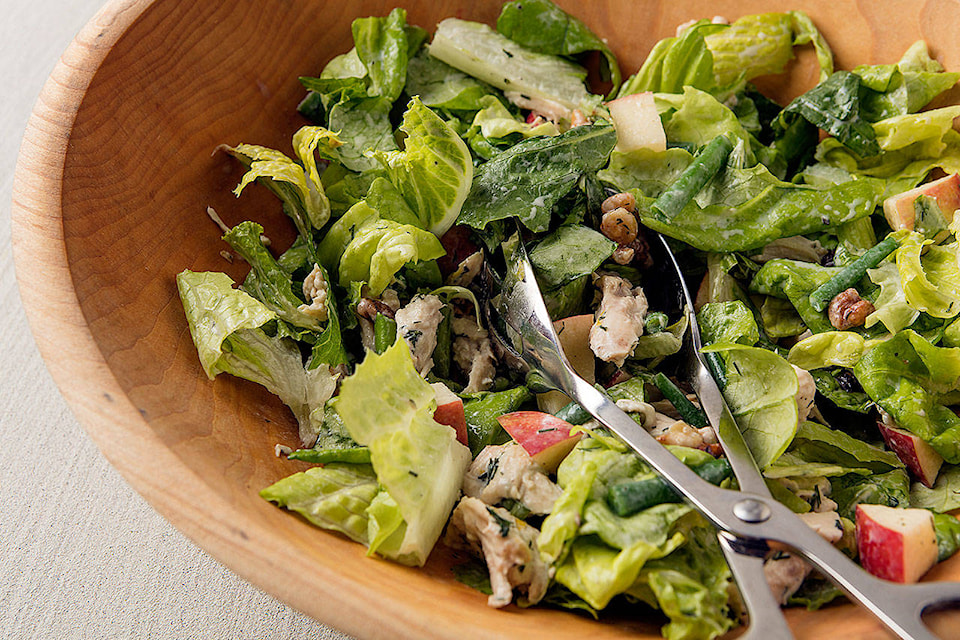by Chef Dez
Most don’t consider salad dressings to be sauces, however they share the same definition: a flavourful liquid that enhances a finished dish. Salads do not all necessarily share the characteristic of being made out of lettuce; they do however almost always depend upon a dressing of one aspect or another.
• ON COOKING: Chef Dez offers crash course on sauces
Oil and vinegar is probably the most common homemade dressing. It can be made very simple or quite complex. The most frequent question I get asked, when it comes to making this type of dressing, is “what oil to vinegar ratio should I be using?” Firstly, this depends upon one’s tolerance and desire for acidity. I personally prefer a 2:1 ratio of oil to vinegar: meaning two measurements of oil for every one measurement of vinegar. However, a 1:1, 3:1, 4:1, or even a 5:1 ratio can function just as well, depending on one’s tastes. Lemon juice, lime juice, or other acids can be used with, or in place of, the vinegar if desired. The technique of making a satisfying oil and vinegar dressing will rely more upon the balance of flavours rather than just the ratio used.
All oil and vinegar dressings are emulsified (mixed together) before serving. They can be either temporarily emulsified or permanently emulsified. A temporary emulsion is when the mixture is shaken, and the oil and vinegar combine temporarily. Shortly after, the oil and vinegar will separate once again.
A permanent emulsion requires the use of an emulsifier, such as egg yolk. The egg yolk particles will coat both the oil and vinegar particles, and keep them suspended in each other rather than separating. To create this, the oil must be whisked in vigorously while adding it very slowly to the other ingredients.
All emulsification, whether temporary or permanent, always work better at room temperature, as oil is harder to mix when it is cold.
Mayonnaise is basically an emulsion of egg and oil. Dressings made with mayonnaise as a base are very popular as well. Potato salad is a classic example of this.
• ON COOKING: Don’t freeze out this key food option, says Chef Dez
Mayonnaise, however, is in drastic need of additional flavours in order for it to become a great salad dressing. Please don’t be afraid to experiment, as some of the best dressings come from being creative and trying something new. Most importantly, it is a necessity to taste and re-season once the salad has been assembled with the dressing. Potatoes or pasta, for example, on their own are very bland. They will definitely reduce the impact of flavour in the dressing. Have you ever been to a picnic when someone has volunteered to bring the potato salad, and it tasted incredibly bland? You automatically think to yourself “did they even taste this?”
Salad dressings can also be made from other ingredient bases such as sour cream or yogurt. While these would be replacements for a mayonnaise-based dressing, they do lack the richness mayonnaise provides. However, low- or non-fat varieties of sour cream or yogurt would be ideal for accommodating a lower fat diet. Keep in mind that these may be low in fat and high in protein, but may also be high in carbohydrates. Therefore, they would not suit all forms of dieting.
As previously mentioned, the main focus, on whatever dressing one is making, should be on developing flavour.
Dear Chef Dez,
I always have trouble making caesar salad dressing. I always make sure I add the oil very slowly when combining, however, it always separates rather than coming together to form a nice creamy dressing. I know the egg I’m using in the recipe is supposed to keep it together. What am I doing wrong?
Leah L., Abbotsford
.
Dear Leah,
Three things come to mind immediately.
One is, as I mentioned above, to make sure that the ingredients (especially the oil) are as close to room temperature as possible.
Two, if the recipe calls for the use of whole eggs, substitute for just egg yolks, as they are the emulsifying ingredients, not the egg whites. For example, use two egg yolks to replace one whole egg.
Three, add the oil in a slow stream into the other ingredients using a food processor, rather than hand whisking. If your dressing still “breaks”, all is not lost. Take the broken dressing out of the processor, and puree another egg yolk while adding the broken dressing in a slow steady stream. The extra egg yolk should help to emulsify it properly.
.
– Chef Dez is a food columnist and culinary instructor in the Fraser Valley. Visit him at www.chefdez.com. Send questions to dez@chefdez.com or to P.O. Box 2674, Abbotsford, B.C. V2T 6R4
Have a story tip? Email: editor@mapleridgenews.com
Like us on Facebook and follow us on Twitter.
